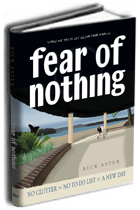I took a photo of my garbage can, but the picture did not look so impressive. You just see a plastic container and you cannot guess what is in it, or indeed, whether it is full or empty. In a way, this mysterious container is a good symbol to wrap up March of Trash with, with or without the photo. That’s because after you have correctly identified something as clutter, once it is out of sight in the trash, it may be surprising how quickly it is forgotten. A high school yearbook? Ah, yes, I think I had a high school yearbook at one time, even if I don’t remember exactly when, or what was in it.
Clutter-busting is not the easiest thing to celebrate. You can’t brag about your specific successes, given the obvious risks of talking about what you threw away. “How could you throw away your high school yearbook?” a friend or family member might demand. “Well, I feel lighter and stronger without it, and my house looks so much better,” hardly seems a complete answer. Letting go of clutter is hard enough without letting people talk you into a momentary feeling of regret. It is safer not to dwell on the specifics of what has been taken away, better to leave it forgotten and focus on what remains.
The effects of clearing clutter are obvious enough anyway without focusing on the clutter itself. To state it simply, with less clutter, the shadows are not so deep. There is more space and energy for today’s new action. “Clutter-busting” is an intentionally noisy word, yet clutter-busting at its best is a quiet process, not clouded by so much fuss and trepidation. It gets easier with practice, not just with the skills gained, but also with the confidence of remembering that the process works.
Around 75 people participated in March of Trash or at least followed along, and that was far more than I expected for such a hastily arranged initiative. Thank you for taking notice of our efforts, and congratulations on whatever trash is no longer part of your daily life as March of Trash wraps up.



No comments:
Post a Comment